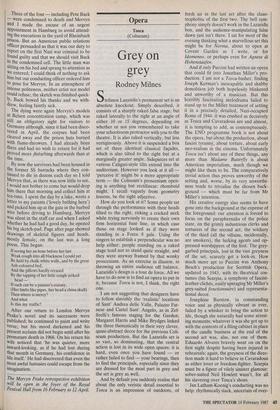Opera Tosca (Coliseum)
Grey on grey
Rodney Milnes
Stefanos Lazaridis's permanent set is an absolute knockout. Simply described, it consists of a sharply raked false stage, but raked laterally to the right at an angle of either 10 or 15 degrees, depending on whether or not you remembered to take your schoolroom protractor with you to the theatre. It is also raked vertically, but less vertiginously. Above it is suspended a box set of three identical classical façades, which is also tilted to the right but at a marginally greater angle. Sidepieces set at various Caligari-style tilts extend into the auditorium. However you look at it all 'perceive it' might be a more appropriate term — the Coliseum's proscenium open- ing is anything but rectilinear: rhomboid might, I recall vaguely from geometry lessons, be the right adjective.
How do you look at it? Some people sat through the performance with their heads tilted to the right, risking a cricked neck while trying nervously to create their own firm horizontal base line, in which case those on stage looked as if they were standing in a Force 8 gale. Using the singers to establish a perpendicular was no help either: people standing on a raked stage tend not to stand quite straight, and they were anyway framed by that wonky proscenium. As an exercise in illusion, in throwing an entire audience off balance, Lazaridis's design is a tour de force. All we have to do now is to find an opera to put in it, because Tosca is not, I think, the right one.
I am not suggesting that designers have to follow slavishly the 'realistic' locations of Sant' Andrea delle Valle, Palazzo Far- nese and Castel Sant' Angelo, as in Zef- firelli's famous staging for the Garden; Margaret Harris and Mike Brydges linked the three thematically in their very clever, quasi-abstract decor for the previous Coli- seum production. But the Lazaridis set is so vast, so dominating, that the central action is lost in its wide open spaces: it is hard, even once you have found — or rather failed to find — your bearings, then to find the principals, especially since they are dressed for the most part in grey and the set is grey as well.
And by default you suddenly realise that about the only veristic detail essential to Tosca is an impression of outdoors, of fresh air in the last act after the claus- trophobia of the first two. The bell sym- phony simply doesn't work in the Lazaridis box, and the audience-manipulating false dawn just isn't there. I sat for most of the evening thinking what a marvellous set this might be for Norma, about to open at Covent Garden as I write, or for ldomeneo, or perhaps even for Agnese di Hohenstaufen.
And if only Puccini had written an opera that could fit into Jonathan Miller's pro- duction. I am not a Tosca-basher, finding Joseph Kerman's inescapable and shabby demolition job both hopelessly blinkered and unworthy of a musician. But this horribly fascinating melodrama failed to stand up to the Miller treatment of setting it in a precisely detailed, Nazi-occupied Rome of 1944: it was crushed as decisively as Tosca and Cavaradossi are and almost, it is tempting to add, as contemptuously. The ENO programme book is not about the opera, but about the production, about fascist tyranny, about torture, about early neo-realism in the cinema. Unfortunately Tosca isn't about any of these things, any more than Madame Butterfly is about American imperialism, much though we might like them to be. The comparatively trivial action thus proves unworthy of the setting and, worse, by its very unworthi- ness tends to trivialise the chosen back- ground — which must be far from Mr Miller's intention.
His creative energy also seems to have gone into the background at the expense of the foreground: our attention is forced to focus on the paraphernalia of the police state, on the grimly industrious clerks and torturers of the second act, the soldiery of the third (all the villains, incidentally, are smokers), the lurking agents and op- pressed worshippers of the first. The grey- garbed principals, lost in the vast greyness of the set, scarcely get a look-in. How much more apt to Puccini was Anthony Besch's production for Scottish Opera, updated to 1943, with its theatrical cos- tumes (his Scarpia, a symphony of fascist- leather clichés, easily upstaging Mr Miller's grey-suited fonctionnaire) and representa- tional decor.
Josephine Barstow, in commanding voice and as physically vibrant as ever, failed by a whisker to bring the action to life, though she naturally had some arrest- ing moments; whatever it was she got up to with the contents of a filing cabinet in place of the candle business at the end of the second act was, alas, not one of them.
Eduardo Alvares bravely went on on the first night despite having been injured in rehearsals; again, the greyness of the direc- tion made it hard to believe in Cavaradossi as either lover or freedom-fighter. Scarpia must be a figure of vilely sinister glamour: sober-suited Neil Howlett wasn't, for all his slavering over Tosca's shoes.
Jan Latham-Koenig's conducting was no help: rhythmically slack, uncertain of over- all pace, glutinous of texture — far too many lines, including those changed in the interest of the updating, were lost. I have always thought Tosca the one absolutely fail-safe piece, and for the first time found it actually boring, even — unimaginably the second act. This must be Jonathan Miller's first palpable failure as producer; Tosca is a feeling man's opera, and highly resistant to a thinking man's approach. He has paid it the compliment of taking it seriously, but in quite the wrong way. The externals, his equivalent of Puccini's bogus and irrelevant historical detail, have swamped the work irreversibly.



























































 Previous page
Previous page